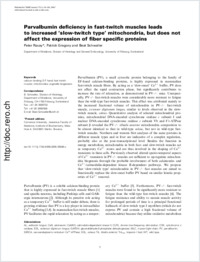Parvalbumin deficiency in fast-twitch muscles leads to increased 'slow-twitch type' mitochondria, but does not affect the expression of fiber specific proteins
- Racay, Peter Department of Medicine, Division of Histology and General Embryology, University of Fribourg, Switzerland - Comenius University, Jessenius Faculty of Medicine, Institute of Biochemistry, Martin, Slovakia
- Gregory, Patrick Department of Medicine, Division of Histology and General Embryology, University of Fribourg, Switzerland
- Schwaller, Beat Department of Medicine, Division of Histology and General Embryology, University of Fribourg, Switzerland
-
2006
Published in:
- FEBS Journal. - 2006, vol. 273, no. 1, p. 96-108
English
Parvalbumin (PV), a small cytosolic protein belonging to the family of EF-hand calcium-binding proteins, is highly expressed in mammalian fast-twitch muscle fibers. By acting as a ‘slow-onset’ Ca2+ buffer, PV does not affect the rapid contraction phase, but significantly contributes to increase the rate of relaxation, as demonstrated in PV–/– mice. Unexpectedly, PV–/– fast-twitch muscles were considerably more resistant to fatigue than the wild-type fast-twitch muscles. This effect was attributed mainly to the increased fractional volume of mitochondria in PV–/– fast-twitch muscle, extensor digitorum longus, similar to levels observed in the slow-twitch muscle, soleus. Quantitative analysis of selected mitochondrial proteins, mitochondrial DNA-encoded cytochrome oxidase c subunit I and nuclear DNA-encoded cytochrome oxidase c subunit Vb and F1-ATPase subunit β revealed the PV–/–tibialis anterior mitochondria composition to be almost identical to that in wild-type soleus, but not in wild-type fast-twitch muscles. Northern and western blot analyses of the same proteins in different muscle types and in liver are indicative of a complex regulation, probably also at the post-transcriptional level. Besides the function in energy metabolism, mitochondria in both fast- and slow-twitch muscles act as temporary Ca2+ stores and are thus involved in the shaping of Ca2+ transients in these cells. Previously observed altered spatio-temporal aspects of Ca2+ transients in PV–/– muscles are sufficient to up-regulate mitochondria biogenesis through the probable involvement of both calcineurin- and Ca2+/calmodulin-dependent kinase II-dependent pathways. We propose that ‘slow-twitch type’ mitochondria in PV–/– fast muscles are aimed to functionally replace the slow-onset buffer PV based on similar kinetic properties of Ca2+ removal.
- Faculty
- Faculté des sciences et de médecine
- Department
- Département de Médecine
- Language
-
- English
- Classification
- Biological sciences
- License
-
License undefined
- Identifiers
-
- RERO DOC 5811
- DOI 10.1111/j.1742-4658.2005.05046.x
- Persistent URL
- https://folia.unifr.ch/unifr/documents/299943
Statistics
Document views: 110
File downloads:
- Texte intégral: 313
